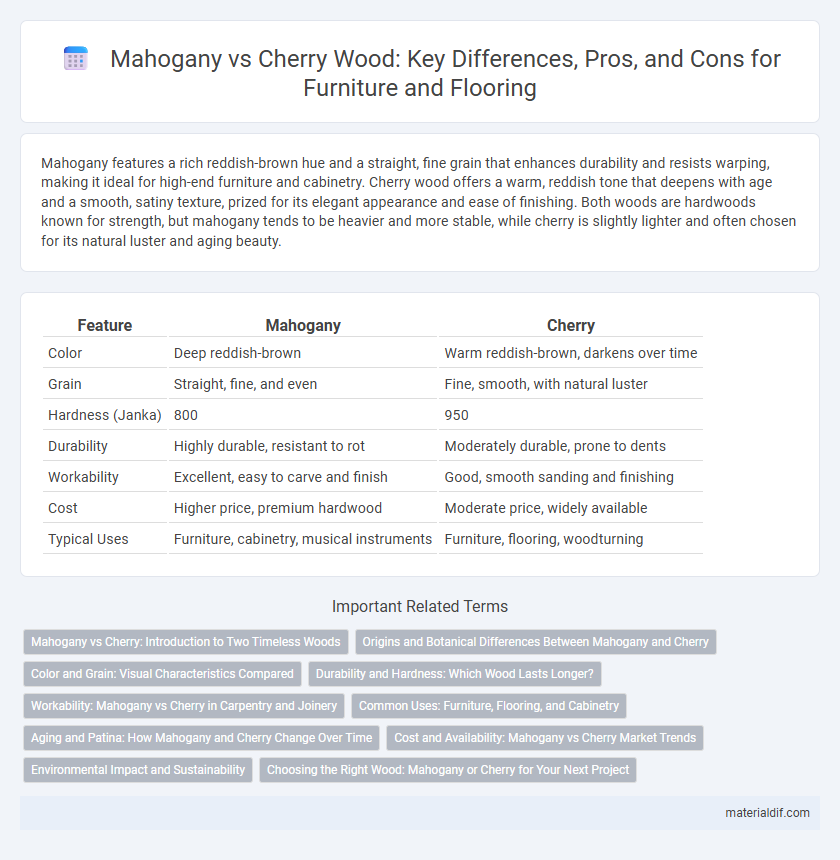Mahogany features a rich reddish-brown hue and a straight, fine grain that enhances durability and resists warping, making it ideal for high-end furniture and cabinetry. Cherry wood offers a warm, reddish tone that deepens with age and a smooth, satiny texture, prized for its elegant appearance and ease of finishing. Both woods are hardwoods known for strength, but mahogany tends to be heavier and more stable, while cherry is slightly lighter and often chosen for its natural luster and aging beauty.
Table of Comparison
| Feature | Mahogany | Cherry |
|---|---|---|
| Color | Deep reddish-brown | Warm reddish-brown, darkens over time |
| Grain | Straight, fine, and even | Fine, smooth, with natural luster |
| Hardness (Janka) | 800 | 950 |
| Durability | Highly durable, resistant to rot | Moderately durable, prone to dents |
| Workability | Excellent, easy to carve and finish | Good, smooth sanding and finishing |
| Cost | Higher price, premium hardwood | Moderate price, widely available |
| Typical Uses | Furniture, cabinetry, musical instruments | Furniture, flooring, woodturning |
Mahogany vs Cherry: Introduction to Two Timeless Woods
Mahogany and cherry are two iconic hardwoods prized for their rich color and durability in fine woodworking. Mahogany boasts a deep reddish-brown hue and a straight grain, making it ideal for high-end furniture and cabinetry, while cherry is known for its warm, reddish-pink tone that darkens beautifully with age. Both woods offer exceptional workability and stability, but mahogany is often favored for its resistance to swelling and shrinking, whereas cherry is valued for its smooth texture and distinctive natural luster.
Origins and Botanical Differences Between Mahogany and Cherry
Mahogany originates primarily from Central and South America, belonging to the Swietenia genus, while Cherry is native to North America and Europe, classified under the Prunus genus. Botanically, Mahogany features a dense, coarse grain with a reddish-brown hue due to its interlocked grain structure, offering durability and resistance to decay. Cherry wood displays a fine, straight grain with a rich, warm reddish-brown color that deepens over time, prized for its smooth texture and workability.
Color and Grain: Visual Characteristics Compared
Mahogany features a rich, reddish-brown hue that deepens with age, exhibiting a straight, fine grain with occasional interlocking patterns. Cherry wood displays a warm, reddish tone that darkens to a deep reddish-brown over time, characterized by a smooth, uniform grain with subtle waves. Both woods offer distinctive visual appeal, with mahogany's bold, pronounced grain contrasting cherry's delicate, flowing texture.
Durability and Hardness: Which Wood Lasts Longer?
Mahogany is known for its exceptional durability and resistance to decay, making it a preferred choice for long-lasting furniture and outdoor applications. Cherry wood, while moderately hard and durable, tends to be softer and more prone to dents and scratches compared to mahogany's dense grain structure. When comparing hardness, mahogany typically rates higher on the Janka hardness scale, indicating greater resistance to wear and a longer lifespan in high-traffic or heavy-use environments.
Workability: Mahogany vs Cherry in Carpentry and Joinery
Mahogany offers excellent workability due to its straight grain and uniform texture, making it ideal for detailed carpentry and intricate joinery. Cherry wood is also highly workable but has a smoother finish and polishes to a rich sheen, favored for fine furniture and cabinetry. Both woods respond well to hand and machine tools, though mahogany's stability reduces warping in complex projects.
Common Uses: Furniture, Flooring, and Cabinetry
Mahogany is favored for high-end furniture, flooring, and cabinetry due to its rich reddish-brown color and exceptional durability. Cherry wood, prized for its warm tones and smooth grain, is extensively used in fine furniture, elegant flooring, and detailed cabinetry work. Both woods offer excellent stability and aging qualities, making them popular choices for luxurious interior applications.
Aging and Patina: How Mahogany and Cherry Change Over Time
Mahogany deepens to a rich, reddish-brown hue with age, developing a luxurious patina that enhances its classic appeal. Cherry wood transitions from a light pinkish tone to a warm, reddish-brown color, creating a smooth, elegant surface over time. Both woods improve aesthetically with exposure to light and air, showcasing unique aging characteristics prized in fine woodworking and furniture making.
Cost and Availability: Mahogany vs Cherry Market Trends
Mahogany typically commands higher prices due to its limited availability and slower growth rate, making it a premium choice in luxury woodworking markets. Cherry wood, more abundant and faster-growing, offers a cost-effective alternative with stable market availability, appealing to both commercial and residential applications. Current market trends reflect increasing demand for sustainably sourced mahogany, influencing its price volatility compared to the consistently accessible cherry wood supply.
Environmental Impact and Sustainability
Mahogany is a tropical hardwood often harvested from rainforests, leading to concerns about deforestation and habitat loss, while cherry wood is typically sourced from temperate forests with more regulated logging practices. Sustainably managed cherry wood forests contribute to lower environmental impact through reforestation and certified harvesting, whereas mahogany faces challenges due to illegal logging and slower growth rates. Choosing FSC-certified cherry wood supports sustainable forestry and reduces the ecological footprint compared to mahogany products lacking verified sustainable origins.
Choosing the Right Wood: Mahogany or Cherry for Your Next Project
Mahogany offers deep, rich reddish-brown hues with exceptional durability, making it ideal for high-end furniture and cabinetry that requires long-lasting strength and a luxurious appearance. Cherry wood provides a smooth texture and warm, reddish tone that darkens beautifully over time, perfect for elegant, classic pieces and fine woodworking projects. Selecting between mahogany and cherry depends on your project's aesthetic preference, desired aging characteristics, and budget considerations, as mahogany tends to be more expensive but more resilient.
Mahogany vs Cherry Infographic

 materialdif.com
materialdif.com